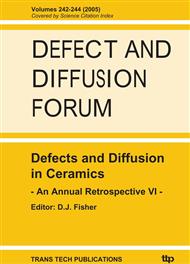p.1
p.9
p.17
p.27
p.43
p.65
p.77
p.95
p.107
Analysis of the Effect of the Oxide Ion Vacancy on the Crystal Structure of La1-xCaxCrO3-δ by High-Temperature X-Ray Diffraction under Various Oxygen Partial Pressures
Abstract:
In order to evaluate potential of La1-xCaxCrO3-δ as a material for interconnector of solid oxide fuel cells, reduction expansion was measured by using high temperature X-ray diffraction under various P(O2). Obtained reduction expansion increased with increasing temperature and Ca content. With combination of obtained lattice constants and oxygen nonstoichiometry data, the effect of oxide ion vacancy on crystal lattice and their thermodynamic behavior have been deduced. It was proposed that expansion behavior by δ of La0.9Ca0.1CrO3-δ can be explained assuming ideal solution model on oxide ion vacancies, however, deviation from ideal solution model was observed in reduction expansion behavior of La0.8Ca0.2CrO3-δ and La0.7Ca0.3CrO3-δ with δ region larger than 0.03 and 0.05, respectively. It was revealed that the crystal system approached to cubic with increase of δ in the region where the deviation from ideal solution model was observed.
Info:
Periodical:
Pages:
9-16
Citation:
Online since:
September 2005
Authors:
Price:
Сopyright:
© 2005 Trans Tech Publications Ltd. All Rights Reserved
Share:
Citation:


